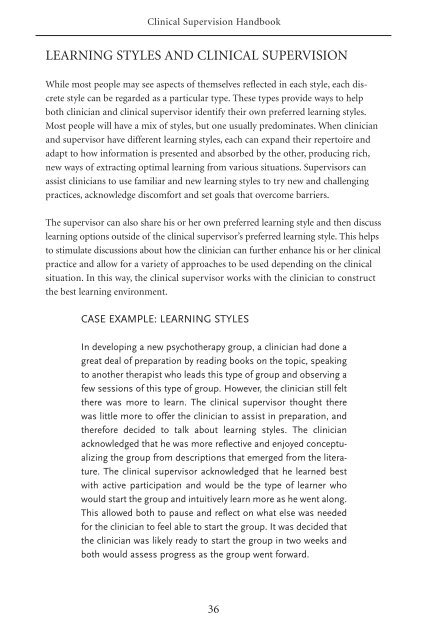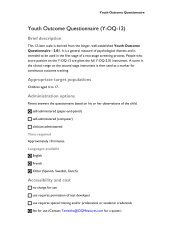Clinical Supervision Handbook - CAMH Knowledge Exchange ...
Clinical Supervision Handbook - CAMH Knowledge Exchange ...
Clinical Supervision Handbook - CAMH Knowledge Exchange ...
Create successful ePaper yourself
Turn your PDF publications into a flip-book with our unique Google optimized e-Paper software.
<strong>Clinical</strong> <strong>Supervision</strong> <strong>Handbook</strong><br />
LEARNING STYLES AND CLINICAL SUPERVISION<br />
While most people may see aspects of themselves reflected in each style, each discrete<br />
style can be regarded as a particular type. These types provide ways to help<br />
both clinician and clinical supervisor identify their own preferred learning styles.<br />
Most people will have a mix of styles, but one usually predominates. When clinician<br />
and supervisor have different learning styles, each can expand their repertoire and<br />
adapt to how information is presented and absorbed by the other, producing rich,<br />
new ways of extracting optimal learning from various situations. Supervisors can<br />
assist clinicians to use familiar and new learning styles to try new and challenging<br />
practices, acknowledge discomfort and set goals that overcome barriers.<br />
The supervisor can also share his or her own preferred learning style and then discuss<br />
learning options outside of the clinical supervisor’s preferred learning style. This helps<br />
to stimulate discussions about how the clinician can further enhance his or her clinical<br />
practice and allow for a variety of approaches to be used depending on the clinical<br />
situation. In this way, the clinical supervisor works with the clinician to construct<br />
the best learning environment.<br />
CASE EXAMPLE: LEARNING STYLES<br />
In developing a new psychotherapy group, a clinician had done a<br />
great deal of preparation by reading books on the topic, speaking<br />
to another therapist who leads this type of group and observing a<br />
few sessions of this type of group. However, the clinician still felt<br />
there was more to learn. The clinical supervisor thought there<br />
was little more to offer the clinician to assist in preparation, and<br />
therefore decided to talk about learning styles. The clinician<br />
acknowledged that he was more reflective and enjoyed conceptualizing<br />
the group from descriptions that emerged from the literature.<br />
The clinical supervisor acknowledged that he learned best<br />
with active participation and would be the type of learner who<br />
would start the group and intuitively learn more as he went along.<br />
This allowed both to pause and reflect on what else was needed<br />
for the clinician to feel able to start the group. It was decided that<br />
the clinician was likely ready to start the group in two weeks and<br />
both would assess progress as the group went forward.<br />
36

















